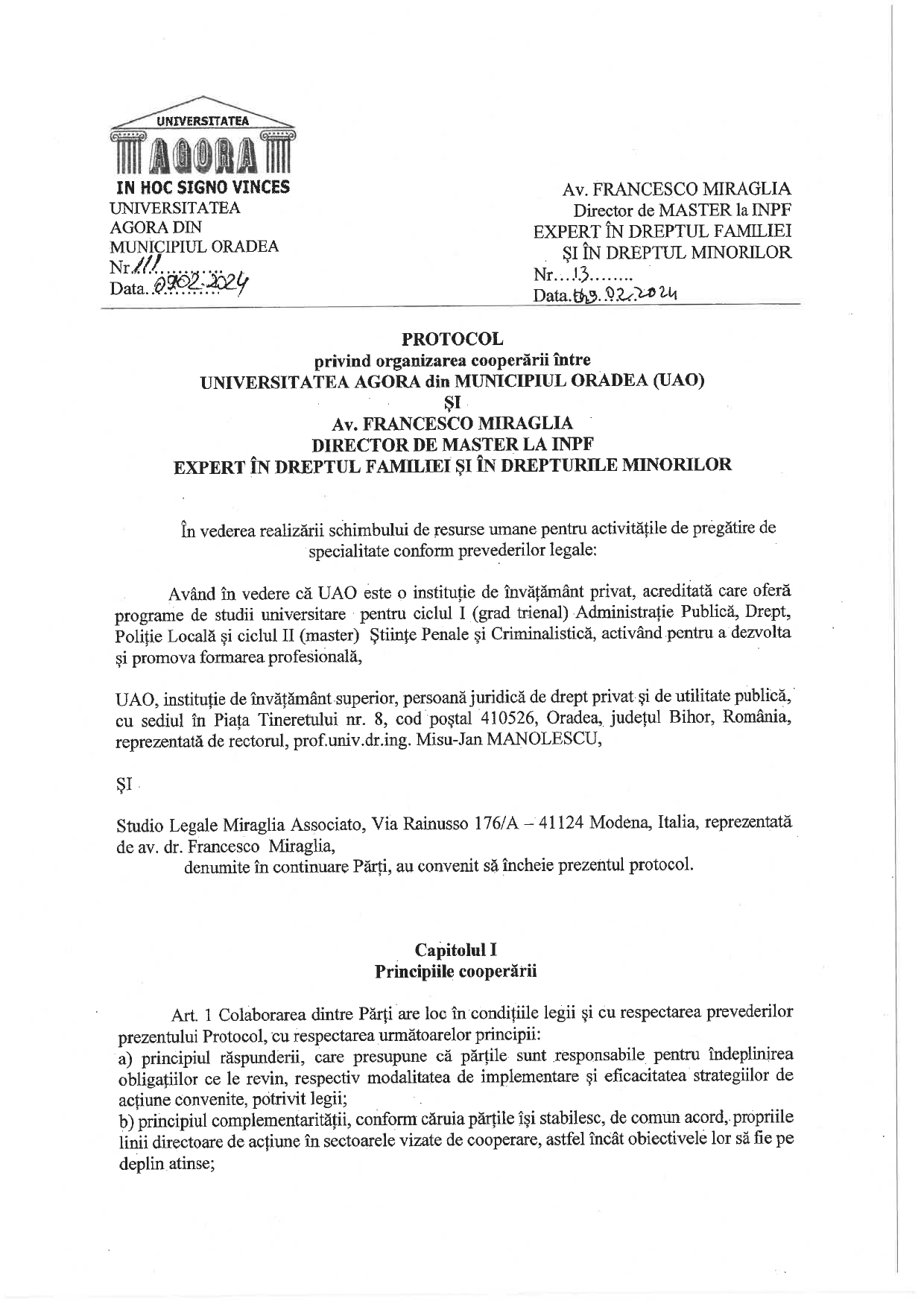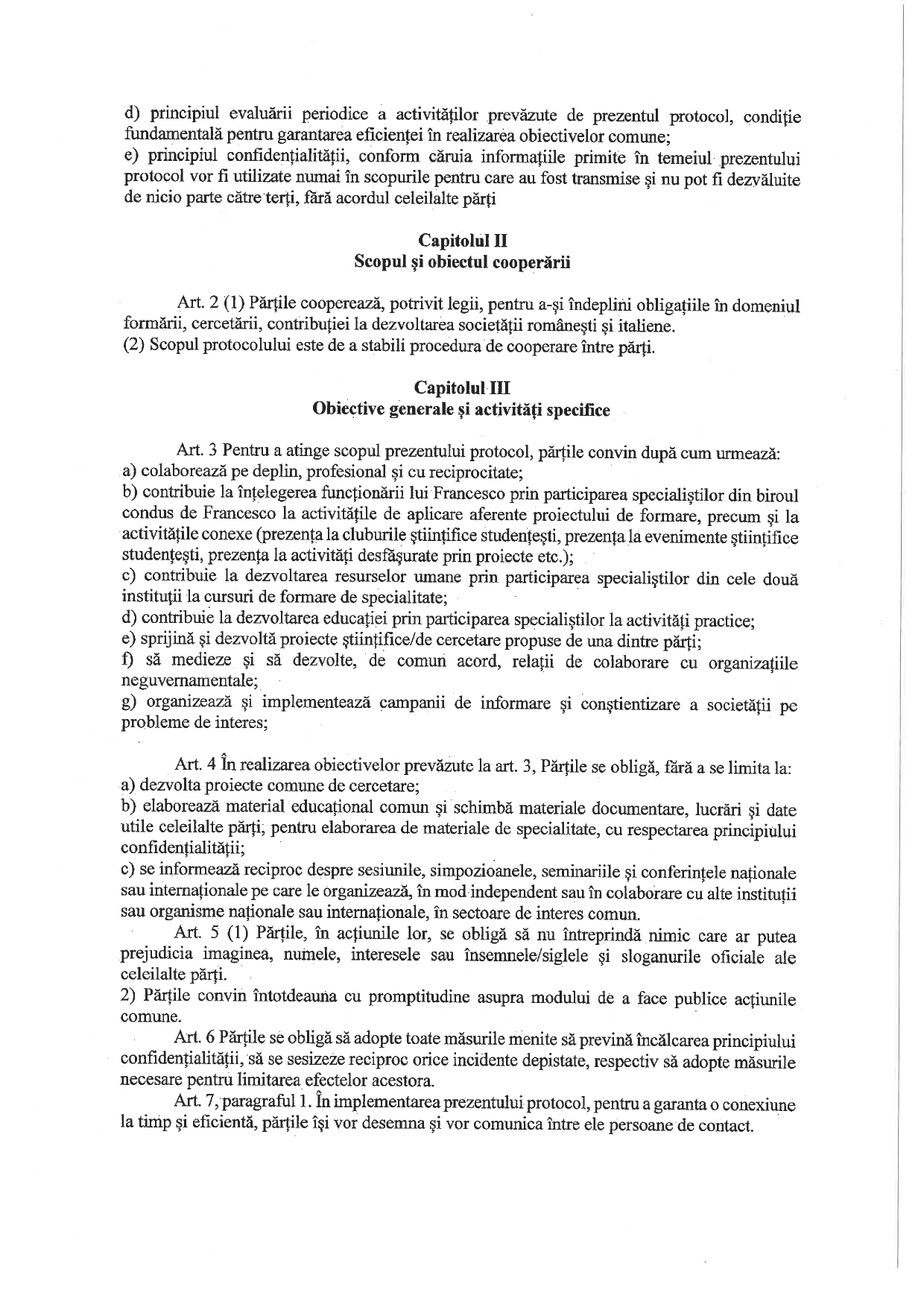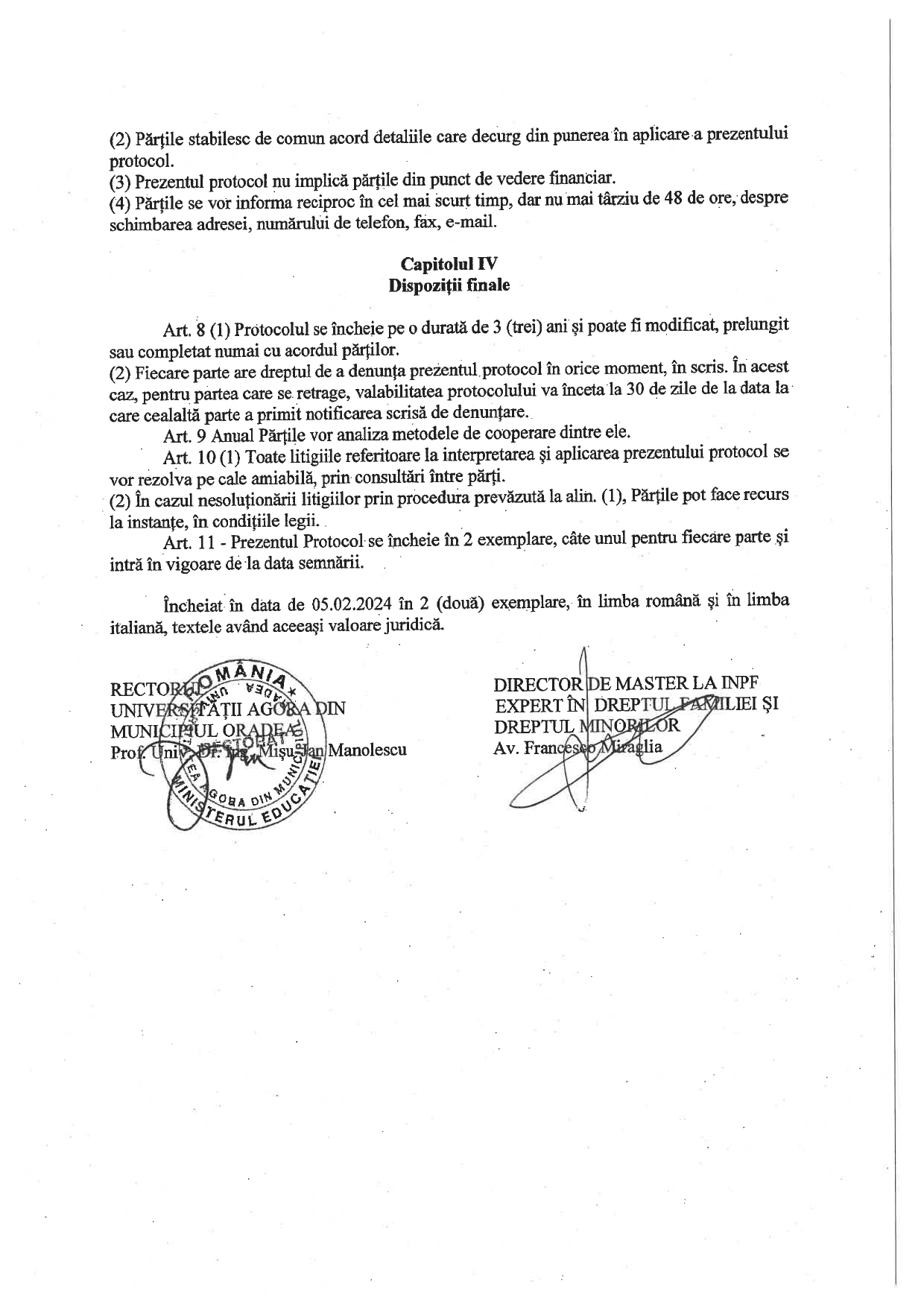L’università Agorà di Oradea e Francesco Miraglia, avvocato del foro di Madrid, hanno recentemente siglato un protocollo di collaborazione, sottolineando l’importanza di questa partnership nel campo del diritto minorile, penale e nella lotta contro la violenza di genere.
Questa collaborazione darà l’opportunità agli studenti dell’Università “Agorà” di partecipare a seminari, corsi e conferenze guidate da Francesco Miraglia, rinomato esperto in diritto minorile e impegnato nella tutela delle vittime di violenza di genere.
La sinergia tra Francesco Miraglia, avvocato del Foro di Madrid e l’Università “Agorà” promette di fornire un importante scambio internazionale di conoscenza e risorse, permettendo agli studenti di accedere a materiale didattico di alta qualità e di apprendere da una delle figure di spicco della giustizia minorile. Questa collaborazione, che durerà 3 anni, non solo migliorerà l’esperienza educativa degli studenti, ma dimostra anche la rilevanza e l’impatto del lavoro e l’impegno di Francesco Miraglia oltre i confini nazionali. Lo stesso Miraglia si è dichiarato soddisfatto ed entusiasta di collaborare con l’Università di Oradea. Questa partnership ci permetterà di offrire agli studenti un’eccellente opportunità di apprendimenti, arricchimento del curriculum con una prospettiva globale e contribuendo alla formazione di futuri professionisti consapevoli e preparati. Lp stesso Miraglia: non posso che essere grato al rettore di Agorà per questa possibilità e non vedo l’ora di avviare questo prezioso scambio di conoscenza.
francesco miraglia Tag
- Sort Blog:
- All
- Articoli Recenti
- Comunicati stampa
- Design
- Evidenza
- GALLERIA
- In Evidenza
- L'inchiesta
- L'indiscreto
- La giustizia e la mala giustizia
- La Vetrina
- Le vostre storie
- Minori
- Modern
- Primo Piano
- Principale home
- Psichiatria
- Scelta di campo
- Sentenze
- Senza categoria
“Diritto all’Ascolto: Il Ruolo Cruciale della Tutela dei Minori nel Sistema Giuridico”
Il tema che mi preme sottolineare in questo beve intervento è sicuramente l’ascolto del minore, soprattutto nell’ambito giudiziario.
Il tema è di cruciale importanza nel campo del diritto di famiglia e nei procedimenti tutti che vedono un minore coinvolto.
Per sottolineare, questo aspetto voglio fare riferimento alla vicenda tragica di Amanda Todd sottolinea drammaticamente le conseguenze potenzialmente devastanti di un sistema che fallisce nell’ascoltare e proteggere i suoi giovani più vulnerabili. Questo tema solleva questioni fondamentali riguardanti non solo il diritto e la procedura ma anche la moralità e la responsabilità
Nel 2012 Amanda Todd, una giovane canadese di 15 anni, si tolse la vita dopo aver subito un prolungato periodo di cyberbullismo. Prima dell’evento, Amanda aveva raccontato la sua storia e cercato di chiedere aiuto attraverso un video su YouTube; nonostante i suoi tentativi di segnalare gli abusi, le risposte delle autorità non furono sufficienti a proteggerla. La vicenda evidenziò le gravi carenze nel sistema di supporto per i giovani vittime di bullismo e l’incapacità delle istituzioni scolastiche e della società nel complesso di ascoltare e intervenire a favore dei minori in difficoltà. Ma cosa significa realmente “ascoltare” un minore? Quanto è importante ascoltare i minori nei procedimenti giudiziari?
L’articolo 12 della Convenzione delle Nazioni Unite sui diritti dell’infanzia stabilisce che ogni minore ha il diritto di esprimere le proprie opinioni; tuttavia, spesso, è proprio questo a mancare quando si tutelano i minori.
Dopo la costituzione del sopra citato articolo, sono state condotte alcune ricerche nel contesto europeo che hanno messo in evidenza come i minori non si sentano coinvolti nelle decisioni che li concernono, infatti ben 2/3 dei bambini in Europa non sono soddisfatti del modo in cui vengono ascoltati nel loro ambiente di vita e di come questo interagisce con loro (The Europe Kids Want, 2019). Le raccomandazioni che ne derivano, pertanto, richiamano i decisori ad un maggior coinvolgimento di bambini e giovani nei dialoghi politici a livello europeo, nazionale e locale, nonché invitano l’Unione Europea ad intervenire per istituire meccanismi di partecipazione dei minori ai processi decisionali sulle questioni che li riguardano. I minori costituiscono un elemento chiave e imprescindibile nella realizzazione di società civili inclusive. La ricerca “Our Europe, our rights, our future”, che nel 2021 ha visto la partecipazione di migliaia di minori tra gli 11 e i 17 anni, sottolinea che, indipendentemente dal background, la stragrande maggioranza degli intervistati vorrebbe partecipare di più alle scelte che li riguardano se ne avesse l’opportunità, con un maggior interesse riscontrato nel genere femminile. Se i bambini si sentono ascoltati in ambito familiare, lo stesso non può dirsi nelle altre sfere della vita sociale come la scuola, ma soprattutto i servizi sociali e sanitari, esprimendo che spesso i professionisti preferiscono parlare con i genitori piuttosto che con loro. Una considerevole percentuale di partecipanti addirittura riferisce che, ai fini di una maggiore protezione dei loro diritti, i minori non dovrebbero interfacciarsi con ulteriori figure professionali, con particolare riferimento agli assistenti sociali, in quanto non considerati figure di ausilio che valorizzano e ascoltano le opinioni e i desideri dei minori.
Alla luce di quanto emerge, la Commissione Europea, al fine di favorire e rafforzare meccanismi di partecipazione dei giovani nelle decisioni che li riguardano, nel 2022 ha istituito la “European Union Children’s participation platform”, uno spazio dedicato a dar voce alle opinioni dei giovani, i quali sono chiamati a condividere le loro priorità, nonché a suggerire strategie efficaci e partecipate per il reale esercizio e rispetto dei loro diritti.
La progressiva evoluzione delle normative nazionali e internazionali sull’ascolto dei minori
evidenzia un riconoscimento crescente dell’importanza di dare voce ai bambini e agli adolescenti
nei procedimenti che li riguardano. L’introduzione di articoli specifici nel codice civile italiano e la ratifica di convenzioni internazionali dimostrano un impegno verso l’incorporamento di queste
pratiche nell’ambito giuridico. Tuttavia, come sottolineato, esistono ancora molte sfide pratiche e interpretative nell’attuazione di questi principi.
Gli strumenti e le competenze necessari per ascoltare efficacemente un minore nei procedimenti giudiziari sottolineano l’importanza di un approccio olistico e multidisciplinare. La comprensione delle capacità di discernimento variabili, il riconoscimento delle potenziali influenze esterne, la
valutazione delle emozioni e la creazione di un ambiente accogliente sono tutti aspetti cruciali per garantire un ascolto genuino e rispettoso.
La necessità di un ascolto efficace va oltre la semplice raccolta di informazioni; è un processo che valida l’esperienza del minore e riconosce il suo valore e la sua autonomia all’interno del contesto
giudiziario. Questo non solo rispetta i diritti del minore ma contribuisce anche a decisioni giuridiche più informate, giuste e sensibili al contesto.
Nel corso degli anni, la pratica dell’ascolto dei minori nei procedimenti giudiziari a livello nazionale ha assunto un ruolo sempre più centrale. Questa trasformazione è dovuta in parte a nuove dinamiche processuali nella legislazione nazionale, ma anche a importanti convenzioni internazionali che hanno evidenziato l’importanza di garantire ai bambini il diritto di essere ascoltati in tutte le questioni che li riguardano.
Già negli anni Ottanta la legge italiana aveva iniziato a considerare la possibilità di ascoltare i figli minori durante i procedimenti di separazione e di divorzio, ma solo se il Presidente del Tribunale lo riteneva necessario.
Nel panorama giuridico internazionale fu la Convenzione di New York sui diritti dell’infanzia del 1989 a stabilire il principio del diritto del minore di esprimere liberamente la propria opinione su questioni che lo riguardavano nei procedimenti giudiziari. Successivamente, la ratifica della Convenzione di Strasburgo sull’esercizio dei diritti del minore nel 2003 ha reso obbligatorio che i minori siano ascoltati nei procedimenti giudiziari su questioni riguardanti il loro affidamento. L’introduzione dell’articolo 155 sexies del codice civile italiano, denominato “Poteri del giudice e ascolto dei minori”, ha sottolineato ulteriormente l’importanza dell’ascolto dei minori in ambito giuridico. L’articolo, infatti, stabilisce l’obbligo del giudice di disporre l’audizione del figlio minore che abbia compiuto i dodici anni, nonché di età inferiore se capace di discernimento.
L’art. 336 bis del Codice civile afferma che l’ascolto del minore è un diritto fondamentale, ma non impone un obbligo categorico ai giudici. In altre parole, la legge prevede una valutazione discrezionale da parte del giudice, che deve considerare alcuni fattori quali l’età del minore, la sua capacità di discernimento e le circostanze specifiche del caso. Allo stesso modo, la clausola di “superfluità manifesta” consente l’omissione dell’ascolto in situazioni in cui l’informazione è già accertata o non contestata, ovvero nei casi in cui l’ascolto del minore non aggiunge elementi utili alla sentenza. Tuttavia, questa disposizione ha sollevato preoccupazioni riguardo al diritto del minore di essere ascoltato, anche in circostanze che implicano una separazione consensuale o un procedimento di divorzio congiunto.
La riforma della filiazione ha rafforzato il diritto dei minori a essere ascoltati, introducendo principi di flessibilità e discrezionalità che consentono al giudice di valutare caso per caso la necessità di ascoltare il minore. Questo approccio mira a bilanciare il diritto del minore a essere ascoltato con la
necessità di tutelare il suo benessere. Tuttavia, la sfida rimane nell’interpretazione e nell’applicazione di queste disposizioni.
Per poter ascoltare in modo efficace è fondamentale possedere non solo competenze giuridiche, ma anche conoscenze extra-giuridiche. In particolare, è necessario:
• comprendere che la capacità di discernimento varia a seconda dell’età del minore e che ciò incide sulla sua capacità di formulare ragionamenti logici, sia concreti che astratti;
• riconoscere che il minore può essere influenzato. Questo aspetto deve essere considerato per garantire un ascolto genuino;
• valutare le emozioni come parte integrante del modo in cui il bambino esprime la sua opinione e la sua storia;
• creare un ambiente accogliente: assicurarsi che il tribunale sia un luogo sicuro e accogliente per il minore, evitando lunghe attese e atteggiamenti disattenti da parte degli adulti coinvolti;
• collaborare con avvocati e consulenti al fine di promuovere discussioni positive e costruttive;
• instaurare un rapporto empatico con il minore mostrando un interesse genuino per le sue parole e sentimenti;
• spiegare al minore, con termini adatti alla sua età, che ruolo avrà il suo ascolto nel procedimento giudiziario. Questo approccio farà sentire il minore parte attiva e non solo oggetto del procedimento giudiziario.
Essere ascoltati non è soltanto un bisogno imprescindibile di un individuo, ma anche un diritto, e l’obiettivo dell’ascolto è comprendere cosa l’individuo pensa della situazione che sta vivendo; farlo in ambito giuridico è indubbiamente diverso dal farlo in ambito psicologico ma per procedere all’ascolto non si può prescindere da una serie di conoscenze extragiuridiche come quelle discusse precedentemente. Integrare queste conoscenze in ambito giuridico permetterà di valutare adeguatamente un caso e di evitare decisioni sbagliate o incomplete che non riflettono gli interessi dei minori, come in un caso preso in carico recentemente riguardante l’affidamento di una minore di solo 7 anni. Nel caso specifico la curatrice della minore non solo non aveva mai incontrato di persona la bambina, ma soprattutto era a 1.200 km distante dal luogo di residenza della stessa bambina.
La stessa curatrice aveva incontrato, la bambina, soltanto mediante videoconferenza, durata soltanto cinque minuti e avvenuta perché́ richiesta dalla madre. Tuttavia, in udienza aveva chiesto al giudice di disporre l’affidamento della stessa bambina al servizio sociale, e di conseguenza addebitando alla
madre una presunta incapacità genitoriale visto che, secondo la curatrice la stessa non era in grado di facilitare il rapporto padre/figlia.
Questo dimostra, secondo il mio pare che prima di tutto, bisogna nominare curatore chi dimostra di avere non solo competenze giuridiche ma anche capacità di ascolto e anche vivere sul territorio per conoscere l’ambiente in cui un minore vive. Come può essere assolto l’incarico di rappresentare gli interessi di un minore se effettivamente non si è in grado di frequentare, conoscere ascoltare il minore? Di fatti, quelle che sono state definite problematiche psichiche e comportamentali della minore non erano altro che un’interpretazione erronea della sua condizione, frutto dell’omissione del suo ascolto, il che avrebbe reso evidente che le sue difficoltà relazionali erano di natura linguistica dato che la minore non parlava la lingua madre del padre (in questo caso l’inglese) e il padre non conosceva in maniera approfondita la lingua italiana. In conclusione, l’ascolto di un minore in ambito giudiziario rappresenta non solo un dovere giuridico, ma anche un imperativo etico. Garantire che i minori siano ascoltati nei procedimenti che li riguardano non solo rispetta i loro diritti fondamentali, ma contribuisce anche a un processo decisionale più giusto e sensibile. Di fatto, le sezioni unite della Corte di Cassazione, hanno svolto un ruolo fondamentale nel consolidare il principio dell’ascolto del minore. Attraverso la sentenza n. 22238 del 21 ottobre 2009, le sezioni riunite hanno ribadito che il mancato ascolto del minore costituisce violazione dei principi del contraddittorio e del giusto processo. Come elucidato dai due casi empirici discussi brevemente in precedenza, l’ascolto di un minore è un processo cruciale e complesso che richiede sensibilità, conoscenza e un approccio multidisciplinare. Pertanto, è fondamentale continuare a sensibilizzare la società, e soprattutto i professionisti in abito ambito giuridico affinché siano preparati alla pratica dell’ascolto e possano condividere le loro conoscenze ed esperienze al fine di promuovere pratiche più eque e rigorose che siano in linea con i veri interessi dei minori. In conclusione, il discorso sull’importanza dell’ascolto del minore nei procedimenti giudiziari ci invita a riflettere su come la legge e la società possono meglio proteggere, sostenere e valorizzare le voci dei giovani. È un appello all’azione per tutti i professionisti del diritto, gli educatori, i legislatori e la società nel suo insieme per garantire che i diritti e il benessere dei minori siano al centro delle nostre preoccupazioni legali e morali. Questa è una responsabilità collettiva che richiede impegno, sensibilità e un costante aggiornamento delle nostre pratiche in risposta alle esigenze in evoluzione dei minori che serviamo.
Francesco Miraglia
Madre denuncia giudice e servizi spciali
L’Università “Agorà” di Oradea sigla una collaborazione con Francesco Miraglia












